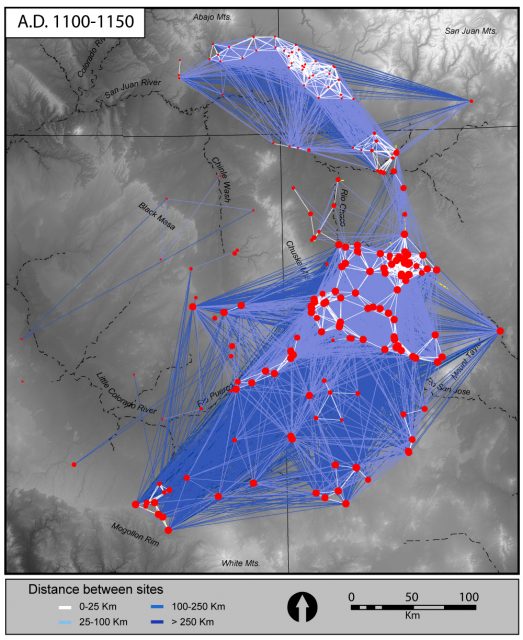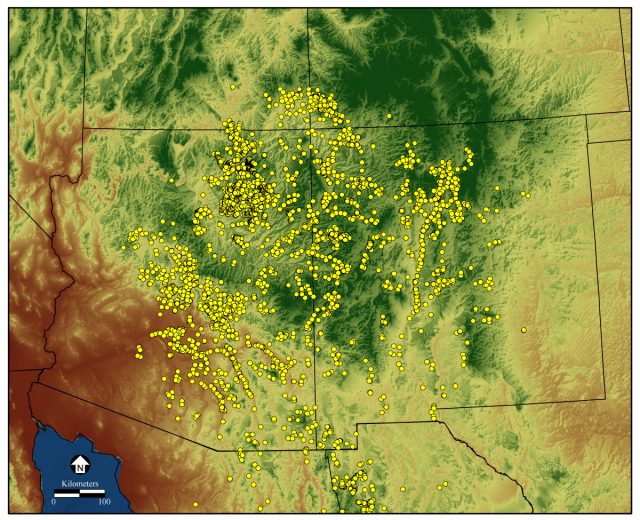Big Data for Big Questions
Archaeology Southwest is pleased to announce that a new joint initiative, cyberSW, has received a $1.7 million award through the National Science Foundation’s RIDIR program (Resource Implementations for Data Intensive Research in the Social Behavioral and Economic Sciences; NSF SBE-1738062). The project is a collaboration among the University of Arizona (Barbara Mills and Sudha Ram), Arizona State University (Matthew Peeples), the University of Colorado, Boulder (Scott Ortman), and Archaeology Southwest (Jeffery Clark). The three-year project was one of four proposals chosen for funding in the third year of the RIDIR program, which supports projects that enable new types of data-intensive research. Mills and Ram are the lead investigators.
“We are very excited to realize the potential of archaeology’s ‘big data’ not only for addressing big questions about life in the past, but also for applying that knowledge to contemporary social issues,” said Jeff Clark, Preservation Archaeologist at Archaeology Southwest and adjunct professor at the University of Arizona. “People have been forming communities, migrating across landscapes, and signaling their identities and ideologies in material ways for millennia, and archaeologists bring that time depth to understanding patterns of human history and interaction up to the present.”
Specifically, the cyberSW project will bring together data from thousands of archaeological projects across the Southwest in a format that will allow researchers and the public to explore broad patterns with a few keystrokes. “Archaeology Southwest will be taking the lead in the citizen science component of the project, by engaging the interested public to actively participate in compiling unpublished data, collecting new data, and using the system to investigate the rich history of the Southwest,” added Clark.
The cyberSW team will merge several large existing databases into one centralized online system. Much will come from the Heritage Southwest Database, which Archaeology Southwest has been managing for several years. That database, which has grown through two NSF-funded projects (the Southwest Social Networks Project and the Chaco Social Networks Project) also undertaken with the University of Arizona, was itself built on the Coalescent Communities Database that Archaeology Southwest and a team of researchers built more than a decade ago.

Additional data will be collected from archives, archaeological reports (especially cultural resource management reports with limited distributions), museum collections, and targeted fieldwork to fill known gaps. Data include information about pottery, stone tools, and other artifact types; settlement room counts and architecture types; and the source-origins of certain kinds of raw materials, such as obsidian and clays. The project encompasses sites dating from AD 800 to the arrival of Europeans in the Southwest in the 1500s.
The result will be a “mega-database” that uses an innovative graph database platform to create an integrated knowledge delivery system. The team hopes that the project serves as an inspiration and invitation. “I think most of us involved hope that the database will continue to grow,” said Matt Peeples, Associate Professor in Arizona State University’s School of Human Evolution and Social Change, and former postdoctoral researcher at Archaeology Southwest. “Moving beyond the greater Southwest where our team works will certainly require us to bring on many new collaborators and address some pretty big challenges. I dream of one day being able to conduct data-driven research like what we’ve been able to do in the Southwest at a continental scale.”

In addition to its role in organizing and supporting the citizen science aspect of data collection and use, Archaeology Southwest will focus its data-gathering efforts on archaeological sites in the Gila River watershed, which stretches from southwestern New Mexico to far southwestern Arizona, where it flows into the Colorado River. A number of large cultural resource management projects and archaeological field schools have been conducted in this 60,000 km2 area over the past 50 years. Archaeology Southwest has a related five-year research, site protection, and public outreach initiative focused on the Gila watershed.
“Many of the archaeological sites that will be represented in cyberSW are of great interest to the public because they are on federally managed lands, including national parks and monuments,” said Bill Doelle, President and CEO of Archaeology Southwest. “All of us involved in the project feel that making these data available to researchers and the public, as well as helping to interpret them for the public, are part of our ethical responsibility.”
Read an article on the project from UA News here.
Details
Related to This
-
Project Fluid Identities
-
Project Chaco Social Networks
-
Post CyberSW 1.0 Launches